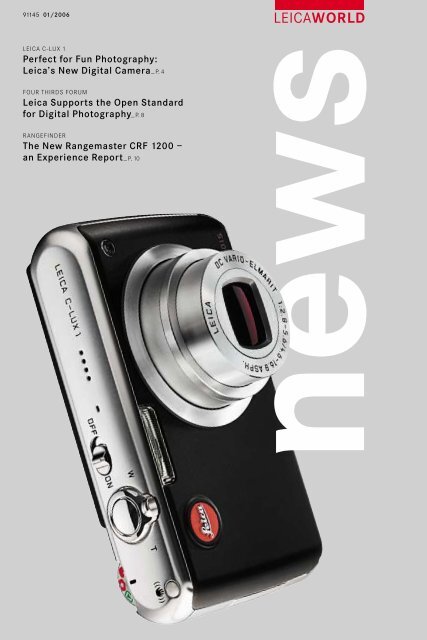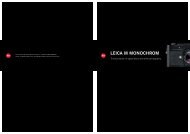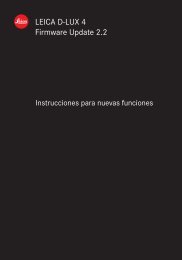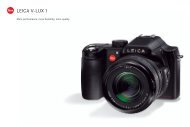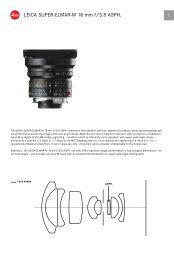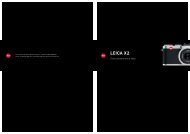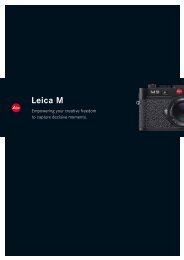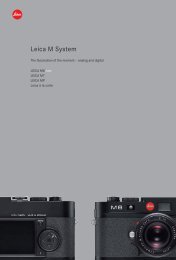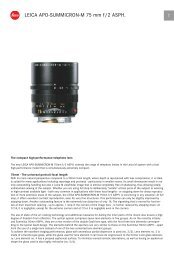leica c-lux 1 - Leica Camera Polska
leica c-lux 1 - Leica Camera Polska
leica c-lux 1 - Leica Camera Polska
Create successful ePaper yourself
Turn your PDF publications into a flip-book with our unique Google optimized e-Paper software.
91145 01/2006<br />
LEICA C-LUX 1<br />
Perfect for Fun Photography:<br />
<strong>Leica</strong>’s New Digital <strong>Camera</strong>_ P. 4<br />
FOUR THIRDS FORUM<br />
<strong>Leica</strong> Supports the Open Standard<br />
for Digital Photography_ P. 8<br />
RANGEFINDER<br />
The New Rangemaster CRF 1200 –<br />
an Experience Report_ P. 10
Heine/Lenz/Zizka<br />
Unmistakable<br />
Now your very own personal <strong>Leica</strong> M camera can look just the way you want it to, and also be equipped<br />
according to your requirements. At your <strong>Leica</strong> à la carte dealer, you can take a look at the different<br />
options, actually feel the available types of leather, and make your choice for your <strong>Leica</strong> à la carte. Would<br />
you like to try out the more than 4,000 possible combinations beforehand See the configurator at<br />
www.<strong>leica</strong>-a-la-carte.com.
10 RANGEMASTER CRF 1200<br />
07 LEICA LENSES in a digital world<br />
04 A life-size view of the LEICA C-LUX 1<br />
Dear friends of <strong>Leica</strong>,<br />
Spring and summer with their fresh, green colors are particularly attractive seasons for photography<br />
and nature watching. There are signs of new life at <strong>Leica</strong>, too. The LEICA DIGITAL-<br />
MODUL-R is now fully available and is being put to excellent use by more and more R photographers.<br />
Our digital compact camera LEICA D-LUX 2 was such a success that it was sold<br />
out after only a few months. In this issue of <strong>Leica</strong> World News we are introducing the new<br />
LEICA C-LUX 1, the first model in another ultra compact and elegant<br />
series of digital compact cameras. Don’t miss it!<br />
There are exciting developments in the legendary <strong>Leica</strong> M system<br />
as well: The eagerly awaited digital <strong>Leica</strong> M camera is to be<br />
launched in the second half of the year. This means a difficult<br />
decision for many a <strong>Leica</strong> M customer: Should I start putting<br />
money aside for the new camera or snap up one of the high performance<br />
lenses first as they can just as easily be used for digital<br />
photography<br />
Another article in this issue describes our involvement in the<br />
Dr. Ralph Nebe,<br />
International Sales and<br />
Marketing Director<br />
so-called Four-Thirds Standard, which will pave the way for further<br />
attractive digital products from <strong>Leica</strong>.<br />
<strong>Leica</strong> Sport Optics, used by our nature-loving customers every<br />
day, will be catering for hunting enthusiasts in particular this<br />
summer. In this issue of <strong>Leica</strong> World News you can find out all about the new extra powerful<br />
LEICA GEOVID 15 x 56 BRF with 15x magnification and our new compact rangefinder LEICA<br />
RANGEMASTER CRF 1200.<br />
As the new International Sales and Marketing Director, I am pleased to be playing a part in<br />
shaping <strong>Leica</strong> <strong>Camera</strong> AG’s bright new future. I am especially looking forward to the dialog<br />
with you. Incidentally, we are opening a new website this summer which should make communication<br />
even more effective!<br />
With kindest regards,<br />
04 LEICA C-LUX 1<br />
Constant companion: A new extra<br />
compact digital camera from <strong>Leica</strong><br />
07 LEICA LENSES<br />
No mistake: <strong>Leica</strong> optics are still the best<br />
and all ready for digital photography<br />
08 FOUR THIRDS SYSTEM<br />
Embracing the future: <strong>Leica</strong> <strong>Camera</strong><br />
joins the consortium for the new standard<br />
09 LEICA GEOVID 15 x 56 BRF<br />
The first 15 x 56 with an integrated<br />
rangefinder: Roland Zeitler put it to<br />
the test<br />
10 RANGEMASTER CRF 1200<br />
New laser rangefinder:<br />
High performance without the weight –<br />
the Rangemaster in everyday use<br />
12 UNIVERSAL LENSES<br />
Well equipped: Two ultra compact zoom<br />
lenses for the <strong>Leica</strong> R system cover a wide<br />
variety of photographic situations<br />
14 LEICA M SYSTEM<br />
Always at your service:<br />
Useful accessories for the <strong>Leica</strong> M<br />
Dr. Ralph Nebe<br />
<strong>Leica</strong> World News 3
LEICA C-LUX 1: AN ELEGANT ALL-ROUNDER<br />
In terms of pure enjoyment value, <strong>Leica</strong> <strong>Camera</strong> AG’s new ultra compact high-performance<br />
digital camera is hard to beat. Equally suitable for everyday use, leisure and sports,<br />
the LEICA C-LUX 1 is a high-tech product that’s also exudes fashionable elegance, and<br />
makes a statement about its owner.<br />
CONSIDER ITS petite but practical dimensions:<br />
3 11 ⁄16 inches wide, 2 1 ⁄8 inches high.<br />
15<br />
⁄16 inches front to back. A camera like this<br />
really does fit into any jacket pocket, briefcase<br />
or handbag. And the sartorially sophisticated<br />
will even be able to accommodate<br />
the new ultra compact digital <strong>Leica</strong> camera<br />
<strong>Leica</strong> behind their breast pocket handkerchief!<br />
In any case, the LEICA C-LUX 1 is the<br />
ideal companion at home and on holiday, at<br />
social events, or when you suddenly discover<br />
something visually memorable while<br />
walking to your destination, shopping, or<br />
simply strolling down the street. The LEICA<br />
C-LUX 1 is always at hand, easy to use,<br />
compact and unobtrusive. When we say<br />
it’s compact however, we mean that it’s<br />
still large enough to hold and operate in<br />
comfort. After all, even the trend towards<br />
miniaturization has its sensible limits.<br />
This new fun-to-use camera proves its<br />
worth in so many different situations that<br />
you’ll want to take it everywhere you go.<br />
Incidentally, the new LEICA C-LUX 1 is at<br />
the cutting edge of the incredibly rapid<br />
technological advances in digital products.<br />
Equipped with a 6 megapixel sensor, it features<br />
extremely short shutter delay, precise<br />
autofocus measurement, and an optical<br />
image stabilizer for carefree photography<br />
whatever the occasion. The exquisite LEICA<br />
DC-VARIO-ELMARIT lens further enhances<br />
the camera’s versatility by offering a focal<br />
length range equivalent to 28–102 mm in<br />
35 mm format, providing an unusually<br />
broad choice of subjects. It covers typical<br />
wide-angle situations with the focal length<br />
of 28 mm (a unique feature for this class<br />
of camera), but the LEICA C-LUX 1 also<br />
has no problem capturing more distant<br />
subjects at the telephoto settings. As<br />
you’d expect, the cameras optic’s based<br />
on state-of-the-art aspherical technology.<br />
In short, if you choose the new LEICA<br />
C-LUX 1, you know you’re benefiting from<br />
the legendary optical expertise of <strong>Leica</strong><br />
<strong>Camera</strong> AG.<br />
And that’s not all. The longlife battery is<br />
supported by the outstanding Venus Plus<br />
processor, renowned for high performance<br />
and low energy consumption. The high-resolution<br />
2.5-inch 207,000-pixel display provides<br />
a brilliant, high-resolution viewing<br />
image. High-sensitivity settings of up to ISO<br />
1600 combined with the optical image sta-<br />
SPECIFICATIONS OF THE LEICA C-LUX 1<br />
Photography type/format<br />
Dimensions (WxHxD)<br />
Weight<br />
Lens<br />
1:1/2.5" CCD sensor with 6.37 m effective pixels<br />
(for aspect ratio 4:3)<br />
approx. 94 x 51 x 24 mm (3 11 ⁄16 x 2 1 ⁄8 x 15 ⁄16 in)<br />
approx. 160 g/5.6 oz (with battery and SD card)<br />
LEICA DC VARIO ELMARIT f/2.8-5.6/4.6-16.8 ASPH.<br />
(corresponds to 28–102 mm for the 35 mm system)<br />
Film speed setting Automatic or manual ISO 80, 100, 200 or 400<br />
(in high-sensitivity mode 800–1600)<br />
Scene modes<br />
Monitor<br />
Storage medium<br />
Scope of delivery<br />
Warranty<br />
Simple mode, normal image, macro, SCN modes (portrait,<br />
soft skin, landscape, sport, night portrait, self-portrait, food,<br />
party, candlelight, fireworks, starry sky, snow, baby1, baby2,<br />
high sensitivity), moving image, replay<br />
2.5" polycrystalline TFT color display with 207,000 pixels<br />
SD memory card, MultiMedia card (still pictures only)<br />
Battery charger, battery, 64 MB SD memory card, AV cable,<br />
USB cable, AC cable, wrist strap, CD-ROM with software<br />
(Adobe Photoshop Elements 4.0, Quicktime Movie Player)<br />
2 years<br />
bilizer guarantee sharply focused, blur-free<br />
photos even in dim light. A candlelight dinner<br />
is just as easy for the LEICA C-LUX 1 to<br />
handle as the fast-moving subjects encountered<br />
in sports, games and other<br />
leisure activities. For all those unexpected<br />
encounters and photo oppourtunities, the<br />
C-LUX 1 is instantly ready for action. It can<br />
even capture exciting video movies in VGA<br />
quality. To sum it up, this little digital <strong>Leica</strong><br />
is a true all-rounder for taking an incredible<br />
variety of photographs, for hobbies or work,<br />
at home or away.<br />
4 <strong>Leica</strong> World News
A life-size view of the LEICA C-LUX 1<br />
<strong>Leica</strong> World News 5
The attractively colored leather case is perfect for keeping the<br />
LEICA C-LUX 1 safe wherever you take it.<br />
Happily, the camera’s intrinsic value is<br />
expressed on the outside as well, with<br />
sound craftsmanship and a modern design<br />
that is both stylish and practical and makes<br />
this new model instantly recognizable as a<br />
member of the prestigious <strong>Leica</strong> family. It’s<br />
easy to hold, caresses the senses – whether<br />
in the black or silver chrome version – or to<br />
put it simply: It looks great. With its slightly<br />
rounded sides, uncluttered front and large<br />
LCD monitor on the back, the LEICA C-LUX 1<br />
is a real eyecatcher. And it’s a camera that<br />
will give you pleasure for years to come.<br />
6 <strong>Leica</strong> World News
LEICA LENSES: STILL THE BEST IN A DIGITAL WORLD<br />
What happens to my prized <strong>Leica</strong> lenses in the brave new digital world It’s a question<br />
posed by many <strong>Leica</strong> customers. The answer: <strong>Leica</strong> optics are still the best and, without<br />
exception, fully equal to the demands of today’s digital technology.<br />
WE ALL KNOW what photography is: light<br />
passes through a lens and enables the<br />
image formed to be recorded either on a<br />
film or a sensor. This admittedly simplified<br />
description of a complicated process makes<br />
one thing abundantly clear: Every photograph<br />
begins at the lens. That’s why Lens<br />
quality is a decisive factor in determing the<br />
quality of the resulting photo. If a lens is<br />
merely mediocre, it is impossible to produce<br />
a top-quality photo, however sophisticated<br />
the downstream factors (film quality,<br />
number of pixels, etc.) may be. In other<br />
words, a superlative lens is just as important<br />
in digital photography as it is in analog<br />
photography for achieving first-class results<br />
– maybe even more so!<br />
Optically and mechanically, <strong>Leica</strong> lenses<br />
represent the absolute state of the art.<br />
Although this in itself is nothing new, it’s<br />
definitely worth remembering in a digital<br />
context. Whereas average-quality lenses in<br />
analog photography still produce average<br />
results, high-resolution digital sensors mercilessly<br />
expose the weaknesses of a lens.<br />
Strictly speaking, every lens is something<br />
like the squaring of the circle. After all,<br />
every optical element has various inherent<br />
aberrations that impede the process of<br />
achieving a high-resoultion, natural-looking<br />
image. Despite these obstacles, an<br />
experienced design engineer may be able,<br />
by applying cutting-edge simulation and<br />
optimization software, to select and arrange<br />
the individual elements in a lens in such a<br />
way that their individual aberration errors<br />
cancel each other out. This is no easy task<br />
considering the different radii and glass<br />
materials with widely varying refraction<br />
indices, plus the fact that some of the elements<br />
need to move in relation to each<br />
other as the lens is focused or zoomed. But<br />
this is just what <strong>Leica</strong> aims at – backed by<br />
a wealth of experience<br />
However, the design of the optical system<br />
is only one aspect in the production of a<br />
good lens. Ultra high manufacturing standards<br />
are just as important. Traditionally,<br />
the optical manufacturing specifications at<br />
<strong>Leica</strong> have always been substantially tighter<br />
than the industry norm. They have to be,<br />
because the tolerances of the various components<br />
may add up to a total tolerance<br />
that far exceeds our extremely stringent<br />
performance standards. Sometimes even<br />
experienced craftsman find extreme tolerances<br />
demanded to achieve with automatic<br />
machining techniques, and that’s why certain<br />
lenses are finished individually by hand.<br />
It is a well-known fact that <strong>Leica</strong> lenses<br />
meet the most extreme precision-mechanical<br />
specifications. Not so many people<br />
know that the sensors made for <strong>Leica</strong> are<br />
specially matched to the demands of the<br />
<strong>Leica</strong> lenses as well. An ultra-thin protective<br />
filter in front of the sensor ensures that<br />
the performance of the lenses is not<br />
impaired by using a thicker filter glass,<br />
which often results in unwanted reflections.<br />
And whereas the majority of <strong>Leica</strong>’s competitors<br />
use physical low-pass filters when<br />
moiré filtering is required, <strong>Leica</strong>’s low-pass<br />
filter is integrated on the basis of software<br />
so optimum resulition is maintained This is<br />
the only way to fully exploit the definition<br />
potential of each <strong>Leica</strong> lens. To state it succinctly,<br />
it not only makes excellent sense<br />
to choose <strong>Leica</strong> lenses in digital photography,<br />
it also wise to choose a <strong>Leica</strong> digital<br />
camera or Digital Modul R back to complement<br />
them. <strong>Leica</strong>: The best in quality and<br />
performance, now and always.<br />
MK<br />
<strong>Leica</strong> lenses: Cutting-edge technology with<br />
digital compatibility<br />
<strong>Leica</strong> World News 7
FOUR THIRDS SYSTEM: <strong>Leica</strong> on Board<br />
THE SO-CALLED ‘Four Thirds’ system<br />
was initiated by Olympus and Kodak at the<br />
end of 2002 as an open standard that is<br />
optimized for digital capture and future<br />
development, and is designed to overcome<br />
some of the the technical limitations<br />
imposed by using a format with its roots in<br />
analog camera technology. Basically, the<br />
new standard simplifies the development<br />
of lenses that are compatible with cameras<br />
made by a variety of manufacturers and is<br />
perfectly matched to the size and characteristics<br />
of digital image sensors. Once the<br />
type and size of the bayonet mount of the<br />
‘Four Thirds’ forum was standardized as<br />
well, it became e possible to combine products<br />
of different manufacturers going forward.<br />
Besides Panasonic – a strategic partner<br />
of <strong>Leica</strong> <strong>Camera</strong> AG – <strong>Leica</strong> itself has<br />
now joined the ‘Four Thirds’ consortium and<br />
regards the new standard as a welcome<br />
complement to the successful <strong>Leica</strong> M and<br />
<strong>Leica</strong> R system with their wide ranges of<br />
lenses and compact cameras. Moreover,<br />
<strong>Leica</strong> sees the ‘Four Thirds’ standard as an<br />
opportunity to reach a wider customer<br />
audience for its renowned high-performance<br />
lenses in the rapidly expanding digital<br />
SLR sector.<br />
As a first step toward this end, <strong>Leica</strong>, in<br />
cooperation with Panasonic, designed its<br />
first D lens in 4/3 mount, the LEICA D<br />
VARIO-ELMARIT f/2.8–3.5/14–50 mm<br />
ASPH. As you would expect, this lens<br />
meets the exceptionally stringent inspection<br />
and quality control specifications of<br />
<strong>Leica</strong> <strong>Camera</strong> AG and it provides outstanding<br />
performance. And of course the thought<br />
of using this lens on a future digital SLR of<br />
our own was never far from our mind The<br />
new <strong>Leica</strong> D Vario-Elmarit is indeed a first<br />
step on the way to our eventual goal of<br />
offering a high-quality lens line for the 4/3<br />
standard. There are also plans for developing<br />
a complete camera together with Panasonic.<br />
<strong>Leica</strong>’s long-term aim in joining the<br />
‘Four Thirds’ consortium is simple and<br />
direct: to carve out a niche with innovative<br />
high-performance lenses aimed at conoisseurs<br />
and professionals in the repidly growing<br />
digital SLR market.<br />
NEW SUMMILUX: It’s available in silver<br />
IT IS NO Coincidence that the 50 mm<br />
lens is often called the standard focal length<br />
for 35mm photography. It has proven immensely<br />
useful in so many different situations<br />
that for this reason alone it deserves<br />
a place in the basic outfit of every photographer.<br />
In mid 2004, <strong>Leica</strong> <strong>Camera</strong> announced<br />
a completely new design of its<br />
high-speed standard lens – the Summi<strong>lux</strong>-M<br />
f/1.4/50 mm ASPH. The outstanding features<br />
of this timeless classic for the <strong>Leica</strong> M<br />
range are enhanced imaging performance<br />
through the use of an aspherical element,<br />
outstanding quality in the close-up range<br />
resulting from its floating-element design<br />
(the last element changes position with<br />
respect to the other optics during focusing)<br />
plus consistently high imaging performance<br />
due to the use of high-refraction glass<br />
and elements with partial dispersion.<br />
Whether it’s used for selective focus in the<br />
macro range, high-contrast available light<br />
photography, or landscapes with impressive<br />
depth of field, the new 50mm Summi<strong>lux</strong><br />
delivers convincing performance whatever<br />
the situation. For all those owners of a<br />
classic M outfit in silver who have hesitated<br />
buying one until now, this is your chance:<br />
To match the camera: the 50 mm Summi<strong>lux</strong><br />
with silver chrome finish<br />
The LEICA SUMMILUX-M f/1.4/50 mm<br />
ASPH. is finally available in a matching silver<br />
chrome version. Ask your authorized<br />
<strong>Leica</strong> dealer for details.<br />
8 <strong>Leica</strong> World News
LEICA GEOVID 15X56 BRF<br />
Seeing more implies recognizing fine details, discerning more and ultimately, knowing<br />
more about what is being observed. That is exactly what the new LEICA GEOVID15 x 56 BRF<br />
binocular delivers. In addition to providing high magnification, it also offers the observer<br />
the benefits of an integrated laser rangefinder. A test report by Roland Zeitler.<br />
WEIGHING ONLY 1300 g (46 oz), the<br />
15x56BRF has a very balanced and steady<br />
feel. Thanks to its excellent weight distribution,<br />
handheld observation is supremely<br />
comfortable. For prolonged observation,<br />
the use of a tripod and the <strong>Leica</strong> Binocular<br />
Adapter is recommended. Because of its<br />
large 56 mm objective, the binocular can<br />
also be used very effectively at twilight.<br />
The optics are treated with an abrasion<br />
resistant <strong>Leica</strong> HDC coating. This yields<br />
a razor-sharp image with superb color<br />
fidelity and rich contrast. It is precisely the<br />
high image brilliance with good contrast<br />
that makes it possible to discern fine<br />
details at this high magnification that would<br />
otherwise remain hidden. Furthermore,<br />
the binocular offers the possibility of laser<br />
rangefinding from 10 m (10.9 yd) to approximately<br />
1200 m (1312 yd). To this end, a<br />
laser beam is emitted along the main axis<br />
of the lens, the reflected light is gathered<br />
by the lens and directed to the measuring<br />
cell by means of a beamsplitter prism.<br />
The distance is shown immediately by<br />
means of a red LED display in the right ocular.<br />
An outline of the measuring field is also<br />
shown in the same ocular. The intensity of<br />
the LED display automatically adjusts itself<br />
to the ambient brightness. There is no<br />
flare. By pressing the key on the top of the<br />
binocular continuously, the measurement<br />
shifts to a scanning mode. This is ideal<br />
when one wishes to measure the distance<br />
to different or rapidly moving subjects in<br />
rapid succession. The large focusing drum<br />
is positioned conveniently at the central<br />
shaft. The diopter compensation can be<br />
set at the left ocular and parallax compensation<br />
is provided for the LED display at the<br />
right ocular. The LED display can thus be<br />
adjusted for optimal focus. The oculars are<br />
optimized for eyeglass-wearers with rotating<br />
eyecups with two click positions.<br />
Thanks to the use of roof prisms with<br />
phase correction (P40 coating), the binocular<br />
is very slender, but 210 mm (8.4 inches)<br />
high. The very sturdy aluminum die-casting<br />
is completely coated with a soft, grippable<br />
rubber armoring. The Geovid easily withstood<br />
rough handling and several strong<br />
impacts. It remained watertight when<br />
Top class optics, dependable measurements thanks to the high performance laser:<br />
Roland Zeitler tests the new <strong>Leica</strong> Geovid.<br />
immersed in a 50 cm (nearly 20 inches)<br />
deep water container. It is also filled with<br />
nitrogen to prevent the interior from steaming<br />
up.<br />
The new 15x56 can be used for numerous<br />
applications. During a hunt, a ram can still<br />
be viewed very clearly at 100 or 150 m<br />
(109 or 164 yd). Strong roebuck antlers<br />
can easily be discerned at great distances<br />
without alarming the game. I especially<br />
appreciated the powerful magnification<br />
while hunting in a field where game was<br />
standing in the open at a great distance –<br />
or when a fox was moving under the cover<br />
of a distant hedge. Mounted on a tripod, it<br />
is simply perfect for hunting varmints such<br />
as prairie dogs or woodchucks. Being able<br />
to ascertain the measured distance to the<br />
game is most important for a successful<br />
hunt. It is probably also ideal for hunting on<br />
horseback, in the wilds of the Yukon, or in<br />
Montana. It can be used equally very effectively<br />
for hunting rams or mountain goats<br />
or for stalking wapiti or moose. In such situations,<br />
observation and shooting must, of<br />
necessity be performed at great distances.<br />
When a wapiti buck is standing in the<br />
shade of a tree during the early hours of<br />
the morning, the bright optics reveal the<br />
details of its antlers. It enables you to<br />
decide whether it is legal for shooting or<br />
whether it is to be spared.<br />
In practice, the very quick rangefinding and<br />
the LED distance display were most impressive.<br />
The binocular performed dependably<br />
and accurately. Game could readily be<br />
ranged up to approximately 1150 m (1258<br />
yd), highly reflective subjects like houses<br />
even up to 1368 m (1496 yd). The high-performance<br />
laser also permits distance<br />
measurements under difficult conditions.<br />
Precise rangefinding ability paired with<br />
top-class, sharp and brilliant optics made it<br />
a genuine pleasure to use this new Geovid<br />
binocular.<br />
The slender Geovid was easy to carry and<br />
it readily made excellent handheld observation<br />
possible. All in all, it is a truly practical<br />
observation instrument for specialized<br />
fields of application, for which it is supremely<br />
suitable.<br />
ROLAND ZEITLER<br />
<strong>Leica</strong> World News 9
LEICA RANGEMASTER CRF 1200<br />
Hunters will really appreciate it: The new <strong>Leica</strong> Laser Rangefinder CRF 1200 delivers the<br />
same high performance, yet it is even smaller and lighter than its illustrious predecessor.<br />
Roland Zeitler tested the new Rangemaster, at times even under extreme cold weather<br />
conditions.<br />
Small, lightweight, high-performance:<br />
The new Rangefinder in practical use.<br />
TECHNICAL DATA AT A GLANCE<br />
Front lens diameter<br />
Magnification<br />
Exit pupil<br />
24 mm<br />
7x<br />
Twilight factor 13<br />
Field of view at 1000 m<br />
3.4 mm<br />
115 m<br />
Field of view at 1000 yds 347 ft<br />
Diopter compensation<br />
Prism system<br />
Dimensions (W x H x D)<br />
Weight<br />
Watertightness<br />
Body<br />
Range<br />
Measurement accuracy<br />
Display<br />
+/- 3.5 diopters<br />
THE NEW <strong>Leica</strong> Laser Rangefinder CRF<br />
1200, while maintaining the very same<br />
high standard of performance, is now much<br />
smaller and handier than its popular predecessor.<br />
The new Rangemaster 1200 is just<br />
about palm-size. Weighing only 220 g<br />
(7.8 oz) with the battery, it practically disappears<br />
in your hand! Its small size even<br />
allows it to be stowed in a purse or a pocket.<br />
Of course it also fits in any pocket of a<br />
hunting jacket. It even fits well in a Napoleon<br />
pocket. That is especially useful in regions<br />
with cold climates like the Arctic, because<br />
then it benefits from the warmth of the<br />
body, so the performance capability of the<br />
battery (3 Volt CR2 Lithium) is maintained<br />
in such frigid areas.<br />
I used the predecessor of this new model<br />
at full capacity in the Canadian Arctic at<br />
minus 40 degrees Celsius (which is also<br />
minus 40 degrees Fahrenheit). The small<br />
laser rangefinder can, of course, also be<br />
carried in its convenient Cordura belt case,<br />
Roof prism system with P40 phase-correcting layer<br />
113 x 74 x 34 mm (4 7 ⁄16 x1 3 ⁄8 x 3 inches)<br />
approximately 220 g (7,8 oz) including the battery<br />
Up to 1 m (3.2 ft) water depth (0.1 bar)<br />
Maximal measuring time approximately 0.9 s<br />
Carbon-fibre-reinforced synthetic material with soft lacquering<br />
From 10 m to approximately 1100 m (11 to 1203 yd)<br />
+/- 1m up to 366 m, +/- 2 m up to 732 m, +/- 0.5% beyond 732 m<br />
+/- 1.1 up to 400 yd, +/- 2.2 up to 800 yd, +/- 0.5% beyond 800 yd<br />
LED display 4 digits, automatic brightness adjustment<br />
Laser Eye-safe, invisible laser in accordance with EN and FDA Class 1<br />
Laser beam divergence<br />
Advantages<br />
Disadvantages<br />
2.5 x 0.5 mrad<br />
Very reliable distance measurement, large measurement range,<br />
Very small, lightweight and handy, one-hand operation, robust and<br />
watertight, high-grade optics (monocular), flare-free display<br />
None<br />
which is tear-proof and virtually impervious<br />
to climate changes. The case has a quick<br />
closure that can be opened quietly for fast<br />
removal of the new Rangemaster from the<br />
belt case. An eyelet even makes it possible<br />
to carry it on a cord around the neck. In<br />
spite of its reduced overall size, the lens<br />
diameter has been increased from 21 to 24<br />
mm, which further enhances its optical performance<br />
by approximately 15%.<br />
The body of the new Rangemaster consists<br />
of a sturdy, impact-resistant and fibre-reinforced<br />
synthetic material. It protects the<br />
optics and the electronics perfectly, even<br />
against rough handling. The threaded battery<br />
compartment cover, with its star-textured<br />
surface and a central slot for a coin,<br />
is also pleasantly convenient. As a result,<br />
the cover can easily be unscrewed by hand<br />
without any tools, for quick and comfortable<br />
battery replacement wherever you<br />
happen to be. The black soft lacquer surface<br />
of the body has a velvety matte finish<br />
that is slip-proof and has a ‘warm feel’<br />
even in very cold temperatures. The flat<br />
lower part has a tubular housing for the<br />
optics and the 7x24 monocular.<br />
The upper portion has a molded grip<br />
recess and a button for activating the laser.<br />
The rangefinder can be held very comfortably<br />
at eye level. The index finger comes to<br />
rest practically automatically on the activating<br />
button. This very ergonomic shape<br />
is combined with attractive styling. The<br />
vertical positioning in the hand results in<br />
an optimal alignment during observation.<br />
The new rangefinder is virtually predestined<br />
for one-hand operation. The ocular<br />
has a steep thread for quick diopter adjustment<br />
(+/- 3.5 diopters) that turns uniformly<br />
and smoothly even in cold temperatures.<br />
Its rather tight movement prevented unintentional<br />
setting changes during field use.<br />
The ocular is, of course, optimized for eyeglass<br />
wearers and covers the complete<br />
field of view of 115 m at 1000 m (126 yd at<br />
1094 yd). The ocular is equipped with a<br />
collapsible eyecup.<br />
The optics deliver a brilliant, bright and<br />
razor-sharp image. The very high contour<br />
sharpness is extraordinary, as is the clear,<br />
dimensional image, which has very good<br />
contrast. Resolution is also remarkably high.<br />
10 <strong>Leica</strong> World News
Smart appearance: The new <strong>Leica</strong> Rangemaster CRF 1200 – Shown actual size<br />
There were no unpleasant reflections in<br />
backlit situations or with in viewing snow<br />
scenes. The high-grade multi-coated optics<br />
delivered superb performance even under<br />
difficult lighting conditions. That also<br />
applies to its use at twilight. The monocular<br />
with its phase-corrected roof prism<br />
delivers an undistorted image, even in dim<br />
light or in backlit situations. The phase<br />
correction prevents interference effects.<br />
Therefore the new Rangemaster 1200 is<br />
useful not only for measuring distances,<br />
but also for monocular observation. The<br />
exterior lens surfaces of the objective and<br />
the ocular are equipped with a very hard,<br />
scratchproof coating. Rubbing them with<br />
my coarse gloves did not affect the coating<br />
in the least.<br />
The laser beam is emitted through a lens in<br />
the lower part of the body and the reflected<br />
laser light is captured by the objective lens<br />
of the monocular and conveyed to a receptor<br />
cell. Sophisticated short-time measurement<br />
technology is used to compute the<br />
distance in meters (in yards for Anglo-American<br />
regions), based on the time elapsed<br />
between the emission and the return of the<br />
laser signal. An LED display in the monocular<br />
shows the measured distance. During<br />
the measurement process, a square red<br />
target area is also outlined in the monocular.<br />
The brightness of the red display is automatically<br />
adjusted to the ambient brightness.<br />
It is thus very easy to see in all kinds<br />
of lighting conditions, without flare or<br />
excessive brightness. It does not employ a<br />
lower quality liquid crystal display. A blinking<br />
signal indicates insufficient battery<br />
power. The electronics independently recognize<br />
different measurement conditions<br />
and automatically set the appropriate<br />
mode – for example, during rain or snow,<br />
so that the rangefinder will not be fooled by<br />
raindrops or snowflakes. Only fog creates<br />
problems for all laser rangefinders. But the<br />
view is very limited in such cases anyway. In<br />
practical use, the laser functioned extremely<br />
dependably and accurately: +/- 1 m at<br />
distances of up to 366 m (+/- 1.09 yd at<br />
distances of up to 400 yd).<br />
Holding the button in activates the scanning<br />
mode, which displays the measurement<br />
results continuously. That enables<br />
hunters to measure the distances to migrating<br />
game. The very rapid display of different<br />
distances is truly remarkable. Distances<br />
to subjects with good reflectance,<br />
such as the sides of a house, can be measured<br />
from as far away as approximately<br />
1300 m (1422 yd). A dark spruce forest<br />
was ranged at exactly 1147 m (1254 yd).<br />
Even under very difficult reflecting conditions,<br />
it was always possible to obtain reliable<br />
measurements of distances of up to<br />
900 m (984 yd). It was no problem at all to<br />
measure the distance of game situated<br />
500 or 600 m (547 or 646 yd) away. A roebuck,<br />
for example, was ranged at 558 m<br />
(610 yd), a stag at 783 m (856 yd) and a<br />
goose was found to be 657 m (719 yd)<br />
away. No measurements can be made at<br />
distances less than 10 m (10.9 yd).<br />
Game can thus be ranged from camouflaged<br />
positions, and branches or other vegetation<br />
within the field of view will not affect<br />
the measurement results. In difficult rangefinding<br />
situations, the scanning mode still<br />
makes it possible to measure the distances<br />
to objects adjacent to the actual subject<br />
very quickly – the rock, for example, on<br />
which a mountain goat is standing.<br />
The new Rangemaster is eminently versatile<br />
for uses ranging from playing golf to<br />
hunting.<br />
It measures distances very accurately even<br />
under the most difficult conditions. The<br />
specified measuring range is 10 to 1100 m<br />
(11 to 1203 yd).<br />
Only 113 mm long, 34 mm wide and 75 mm<br />
high (4 7 ⁄16 x 1 3 ⁄8 x 3 inches) and weighing<br />
only 220 g (7,8 oz), it is supremely handy<br />
and quick to use. Its brilliant optics make it<br />
very easy to distinguish fine details and to<br />
observe the subject accurately. For distant<br />
shots beyond the calibrated shooting distance,<br />
the hunter is compelled to rely on<br />
accurate distance measurements in order<br />
for the shot to achieve the desired success.<br />
Only the laser rangefinder can provide<br />
this distance information dependably.<br />
The <strong>Leica</strong> Rangemaster 1200 is no burden,<br />
even in extreme terrain, yet it provides<br />
invaluable assistance for a successful shot.<br />
I appreciate it for hunting deer and foxes in<br />
my home range just as much as I value it<br />
for hunting mountain goats or snow goats<br />
in remote high mountain regions of the<br />
Rocky Mountains.<br />
ROLAND ZEITLER<br />
<strong>Leica</strong> World News 11
UNIVERSAL LENSES<br />
Ideal for traveling. Zoom lenses make photography easier and reduce the amount<br />
of equipment to the essential. Two lenses for the R series that make a perfect team.<br />
Two versatile lenses are sufficient as the basic outfit for R cameras: the LEICA VARIO-ELMAR<br />
f/3.5–4/21–35 ASPH. and the LEICA VARIO-ELMARIT f/2.8–4.5/28–90 mm ASPH.<br />
THERE’S A LOT to be learned from professionals.<br />
Press photographers have to<br />
get in close to the action if their pictures<br />
are to tell exciting stories. That’s why they<br />
prefer to use short focal lengths. The results<br />
are densely packed, powerful photos that<br />
make you feel as if you are part of the<br />
action. It is the wide-angle view in particular<br />
that creates a sense of immediacy and<br />
therefore a certain authenticity. The photo<br />
becomes the “truth”, and, because the lens<br />
only has to be stopped down slightly for the<br />
depth of field to reach from the foreground<br />
to infinity, it has a lot to tell. A successfully<br />
composed wide-angle photo is like a wellwritten<br />
essay.<br />
One of <strong>Leica</strong>’s lenses for its R SLR system<br />
is an ideal tool. The LEICA VARIO-ELMAR-R<br />
f/3.5–4/21–35 mm ASPH. embraces the<br />
most common wide-angle focal lengths of<br />
21, 24, 28 and 35 mm while measuring a<br />
mere 66 mm. Yet due to the complex design,<br />
the imaging performance is comparable<br />
with that of fixed focal length lenses.<br />
If you have to take photos in a large crowd<br />
where you hardly have room to move, you<br />
can track moving objects, zoom in at the<br />
right moment and take a frame-filling photo.<br />
For the reporter, who has little time to<br />
react to what is happening, this is a big<br />
help. And because the Vario-Elmar-R is<br />
designed as a dual-ring zoom with the<br />
focus set by the first ring and the focal<br />
length by the second, there’s no risk of<br />
making the wrong adjustment when in a<br />
hurry. But what is it that determines the<br />
success of a feature on a specific subject<br />
Certain parts of the picture need highlighting<br />
without losing the sense of the whole.<br />
The portrait of an artist in the middle of his<br />
studio, for example. This is where the wideangle<br />
zoom comes into its own, allowing<br />
the photographer to get close to the person<br />
and make him or her stand out from<br />
the width and depth of the surrounding<br />
space. The contrasts of the fore- and background<br />
have the same priority, no information<br />
is lost. What, for example, would a family<br />
or club celebration be without the group<br />
photo to remember it by Indoor group portraits<br />
in particular are the domain of the<br />
wide-angle zoom. Just imagine travel photography<br />
– impossible without a wide-angle.<br />
The dune landscapes of the Sahara, the<br />
dramatic canyons in the west of the USA,<br />
the towering mountain panoramas of the<br />
Alps – only a wide-angle lens can create<br />
the epic effect of depth stretching into<br />
infinity. And in contrast to this, of course,<br />
the narrow ravines of Bryce Canyon with its<br />
eroded bends as in our illustration. It can<br />
only be accessed in a few places, so certain<br />
views can only be chosen and determined<br />
with a wide-angle zoom. The optical<br />
quality of the lens is particularly noticeable<br />
at the edges of the photo. Which naturally<br />
makes it ideal for interior architectural<br />
shots, too.<br />
If you add another zoom lens to your camera<br />
outfit, you’ll be equipped for (almost)<br />
everything. From the medium wide-angle<br />
to the slight telephoto range, the LEICA<br />
VARIO-ELMARIT-R f/2.8–4.5/28–90 mm<br />
ASPH. is a virtually universal lens that photographers<br />
will particularly appreciate when<br />
traveling. Because it combines all common<br />
focal lengths in terms of focal length spread<br />
in one lens, it can be used as a standard<br />
lens that doesn’t need changing on the<br />
move. You can choose from a wide shot all<br />
the way through to a picture of a child’s<br />
laughing face by simply zooming the<br />
required frame. In portrait photography the<br />
lens is unbeatable. Combining a large<br />
aperture with a long focal length setting,<br />
you can separate people from the back-<br />
12 <strong>Leica</strong> World News
top: In the narrow ravines of Bryce Canyon in the USA, a wide-angle zoom lens comes into its own: Left: It is the unfocused movements of the water<br />
that turn this photograph into an idyllic still life. Right: A telephoto setting with a large aperture makes people stand out against the action.<br />
Photos: Franz Bagyi<br />
ground which is then defocused. Or highlight<br />
them against the crowds at a large<br />
event, as the photo of the couple from the<br />
Carnival in Venice clearly shows. This<br />
works equally well with objects in nature:<br />
look how the blurred swathes of water set<br />
the stage for a solitary pine cone on a<br />
mossy stone. Often enough, it is the details<br />
that make a subject interesting: a window<br />
cross, a door handle, a weathered poster, a<br />
person’s hands. It is the selective view of<br />
the longer focal length that captures the<br />
essence of a scene.<br />
HANS-EBERHARD HESS<br />
<strong>Leica</strong> World News 13
ALWAYS AT YOUR SERVICE: USEFUL<br />
ACCESSORIES FOR THE LEICA M<br />
HANDGRIP M: Secure handling, and more<br />
Photographers trying to create special lighting<br />
effects (for example by holding the flash<br />
off camera) often come up against a sticky<br />
problem: they have to hold the camera in<br />
the other hand and press the shutter release<br />
at the same time! The Handgrip for<br />
the <strong>Leica</strong> M guarantees comfortable and<br />
secure camera handling in such situations.<br />
It is quickly and easily screwed into the camera’s<br />
tripod thread and allows you to fire<br />
the shutter. Another advantage is that the<br />
Handgrip M has its own tripod thread located<br />
directly beneath the lens axis, providing<br />
much better balance with a tripod-mounted<br />
camera. This practical handgrip fits all<br />
<strong>Leica</strong> M models with the exception of the<br />
LEICA M5.<br />
Photo: Alexander Göhr<br />
TABLETOP TRIPOD: Always at the ready<br />
Photo: Alexander Göhr<br />
The <strong>Leica</strong>’s ergonomic design is legendary,<br />
and many great <strong>Leica</strong> photgographs have<br />
been shot hendheld at shutter speeds as<br />
slow as 1 ⁄15 sec or so. When using even<br />
slower shutter speeds, however, a tripod is<br />
indispensable – and the best tripod is<br />
always the one you take with you; in other<br />
words a tripod as compact and lightweight<br />
as possible. This is the idea behind <strong>Leica</strong>’s<br />
tabletop tripod and the reason for its<br />
decades of success. With three folding legs<br />
that can be locked in any position, this<br />
space-saving accessory gives you the extra<br />
stability required to prevent camera shake.<br />
The combination of tripod and ball-andsocket<br />
head allows the photographer to<br />
switch from landscape to portrait format in<br />
a matter of seconds, providing a compact<br />
and flexible tool that guarantees sharp pictures<br />
whatever the situation. The <strong>Leica</strong><br />
tabletop tripod can also be used vertically,<br />
for instance when pressed against a wall. If<br />
the legs are pulled apart so that they are<br />
opposite each other, it can even be held<br />
against your shoulder or chest to provide<br />
the extra support you need.<br />
LENS CARRIER M: Well equipped and versatile<br />
This classic lens carrier for rangefinder<br />
<strong>Leica</strong>s has served many of the great names<br />
names in <strong>Leica</strong> M photography. It screws<br />
into the tripod socket and holds a second<br />
lens while the first is in shooting position<br />
on the camera. This kills three birds with<br />
one stone, so to speak. First, it is an exceedingly<br />
compact and tidy way of carrying a<br />
small camera outfit around on a neck strap.<br />
Second, the lens on the carrier can also be<br />
used as a hand grip to stabilize the camera<br />
for hendheld photography at slow shutter<br />
speeds. And third, it can even serve as a<br />
mini tripod. Incidentally, the lens carrier M<br />
does not hamper film changing in any way<br />
— the T-screw on the baseplate is still freely<br />
accessible. The lens carrier M fits onto all<br />
LEICA M models except for the LEICA M5.<br />
Photo: Alexander Göhr<br />
Imprint<br />
LEICA WORLD NEWS<br />
Is published twice a year in spring and autumn<br />
PUBLISHER<br />
<strong>Leica</strong> <strong>Camera</strong> AG, Oskar-Barnack-Straße 11,<br />
D-35606 Solms, Germany<br />
Tel. +49 (0) 6442 208-111<br />
EDITOR IN CHIEF<br />
Hans-Michael Koetzle DGPh<br />
ALSO WORKING ON THIS ISSUE<br />
Team <strong>Leica</strong> Distribution Germany, Team Product Management,<br />
Team Product Communication, Team <strong>Leica</strong> Akademie,<br />
Roland Zeitler, Hans-Eberhard Hess<br />
ART DIRECTION<br />
Lucie Schmid / Horst Moser, independent Medien-Design,<br />
Widenmayerstraße 16, D-80538 Munich,<br />
Tel.+ 49 (0) 89-29 00 15-0<br />
TYPESET/LAYOUT-FINISH<br />
independent Medien-Design: Peter Oberressl<br />
PROJECT COORDINATION<br />
<strong>Leica</strong> <strong>Camera</strong> AG: Alexandra Althof<br />
independent Medien-Design: Stephanie Wiesner<br />
LITHO<br />
Zehentner & Partner, Munich<br />
TRANSLATION<br />
Rolf Fricke<br />
PRINT<br />
Dönges Druck und Medien, Dillenburg, Germany<br />
14 <strong>Leica</strong> World News
“For me, it’s indispensable !” Extreme free climber<br />
Stefan Glowacz uses a <strong>Leica</strong> Ultravid 32 to plan his route up the face of a<br />
mountain. But the ultra-light and ultra-rugged Ultravids are ideal companions<br />
not only in the toughest climbs, but also for nature and animal observation.<br />
With meticulously selected materials and highest quality optics, they provide<br />
fascinating visual experiences that will remain unforgettable. Experience the<br />
<strong>Leica</strong> Ultravids at your local dealer or conveniently on the internet.<br />
<strong>Leica</strong> <strong>Camera</strong> AG / Oskar-Barnack-Straße 11 / D-35606 Solms / Telephone +49 (0) 6442-208-111 / www.<strong>leica</strong>-camera.com<br />
LEICA ULTRAVID 10 x 32 BR<br />
LEICA ULTRAVID 8 x 20 BR
Fast, stylish, compact :<br />
LEICA C-LUX 1<br />
Elegance that’s more than skin deep<br />
The LEICA C-LUX 1 is an attractive companion<br />
: be it in black or silver finish and<br />
thanks to its metal body measuring a<br />
mere 5 x10 cm, you’ll want to take it with<br />
you wherever you go. And the camera<br />
features more than just a flashy appearance.<br />
Its <strong>Leica</strong> wideangle-to-tele zoom<br />
lens, 6 megapixel resolution, ultra short<br />
shutter delay, precise autofocus measurement,<br />
and the selection of scene modes<br />
will make it easy to capture those precious<br />
moments. See for yourself at your<br />
local <strong>Leica</strong> dealer or now on the internet.<br />
www.<strong>leica</strong>-camera.com


